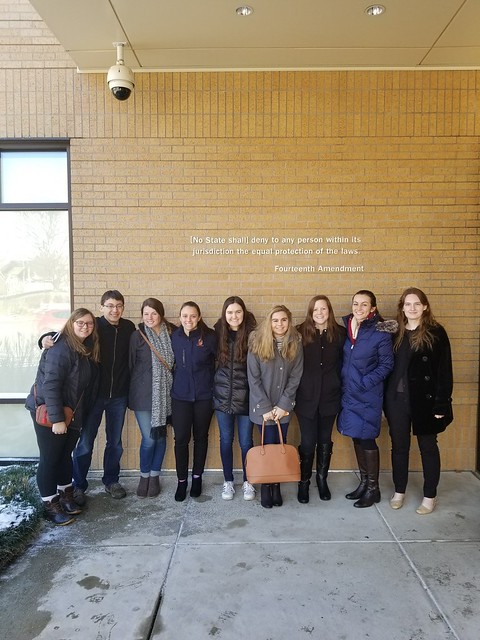At Gettysburg, students are enthusiastic about learning their school’s history and how it intersects with the story of America. This year, a new Eisenhower Institute expert program, Inside Civil Rights, explored the struggle for civil rights past and present both in Gettysburg and around the country.
The Inside Civil Rights program, offered in partnership through the Eisenhower Institute, Garthwait Leadership Center, Center for Public Service, and the Office of Multicultural Engagement, emerged out of the former Leadership Institute, a semester-long program that helped students discover how to make meaningful change in their communities. Inside Civil rights seeks to carry on that banner by extending the programming to a full year and adding in more faculty mentorship.
This year, the program offered an inaugural group of Gettysburg students the opportunity to cultivate their existing passions for promoting civil rights while also provoking them to discover new and complex issues from the past and in the world around them. Throughout the year, participants met with civil rights experts and traveled to sites of significance in Little Rock, AR, and Washington, D.C., with the goal of studying contemporary civil rights issues through the lens of the past.
Gettysburg also provided a historical case study to explore the national civil rights story. The group took advantage of Gettysburg’s insightful faculty, meeting with several professors on campus to learn more about some of the many facets of the civil rights struggle.
Participants began the year with a discussion about Confederate monuments on the Gettysburg battlefield with History and Africana Studies Prof. Scott Hancock. The national debate surrounding the legacy and place of Confederate iconography is especially prevalent in Gettysburg, and students were able to have a critical discussion about the landscape on which they live and study every day.
“The meeting with Prof. Hancock helped me see a side of the monument debate that I hadn’t previously considered,” said Alex Tottser ’18. “I always thought that we could either keep them or get rid of them. Prof. Hancock suggested keeping them up, but using them to discuss their historical implications and the context behind why they were erected when they were.”
The group also met with Civil War Institute Associate Director Jill Titus to discuss school desegregation past and present and History Prof. Michael Birkner to learn more about President Eisenhower and the Little Rock Nine.
At Musselman Library Special Collections, students examined primary documents to learn more about Gettysburg College students’ role in the Civil Rights Movement and the evolution of the College’s efforts to recruit students from more diverse backgrounds.

Inside Civil Rights participants look through items collected by Richard Hutch ’67 during his time registering African Americans to vote in the summer of 1965 with the Summer Community Organization and Political Education (SCOPE) project.
Beyond Gettysburg, the group traveled to Little Rock, Arkansas over winter break to visit Little Rock Central High School and other sites of local and national significance to the struggle for civil rights. One of the focal points of the trip was the unfinished work still left to complete.
View photos from the trip to Little Rock:
“When we look at Little Rock, and we look at Brown v. Board, it is a landmark moment,” said Associate Provost and Dean of Public Policy Programs Robert Bohrer, who has led the program throughout the year, “but the trip to Little Rock tells us there is more work to be done.”
Participants explored lasting racial disparities in education quality within integrated schools, as well as lingering injustices in policies like urban renewal and interstate highway placement. At the city’s Old Statehouse Museum, participants critiqued historical interpretation that either ignored or glossed over the city’s racial inequities and efforts to correct them during the Civil Rights Movement.
Last month, the program visited the new National Museum of African American History and Culture in Washington, D.C.

Inside Civil Rights participants visit National Museum of African American History and Culture in Washington, D.C.
“The National African American Museum reinforced the notion that black people hold a powerful identity and unity within their communities which has allowed them to make great accomplishments, despite the things that have tried to chain them for years,” said participant Jazmin Reynoso Ortiz ’20 after her visit.
While in D.C., participants also met with College Trustee and Alexandria City Attorney James Banks ’80 to discuss the ongoing struggle for civil rights and how to make a difference on campus and in their communities.

Participants talk with James Banks ’80 about how to provoke conversations about civil rights on campus.
Throughout the year, participants have been encouraged to explore the topic of civil rights through different lenses and engage with often uncomfortable conversations.
“From engaging in Professor's Hancock's discussion on the Civil War monuments that surround our campus to walking through the underfunded schools in Little Rock, the program really inspired a change in myself, and the group as a whole, to start having these conversations and work towards being the generation that resolves these enduring injustices in our society,” said participant Emily Wielk ’20.
Learn more about the Inside Civil Rights program and other Eisenhower Institute expert programs.
Originally posted on the Gettysburg College website
Article by Jeffrey Lauck '18, communications and marketing intern
Contact: Carina Sitkus, director of communications and content strategy, 717.337.6803
Posted: Fri, 27 Apr 2018
